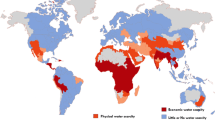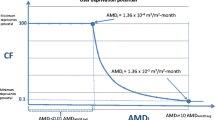Abstract
China has started shifting from relying on supply management to demand management strategy in addressing its water shortage problems. Water option, a financial derivative for water commodity, has been utilized to manage water demands in the United States and Europe since the 1990s but is still novel to China. In this study we analyzed the pros and cons of China’s existing system for water rights transfers and proposed an alternative, flexible trading instrument-water options for China. Incorporating the uncertainty to water option pricing, this study first conducted an empirical analysis of the water option in the water-receiving area of the Hanjiang-Weihe River Transfer Project of China, and then evaluated the benefits of the water option applications. Results show that water option trading can bring water cost saving and increase the potential industrially added value for industrial enterprises in the receiving area, and trading of short-and-medium term water options is more favorable than the long-term water options trading. The novel water option trading proposed in this study, once verified through pilot studies, will be helpful in addressing water shortage problems in China.
Similar content being viewed by others
References
Araral E, Ratra S, 2016. Water governance in India and China: comparison of water law, policy and administration. Water Policy, 2016, 18(S1): 14–31. doi: https://doi.org/10.2166/wp.2016.102
Characklis G W, Kirsch B R, Ramsey J et al., 2006. Developing portfolios of water supply transfers. Water Resources Research, 42(5): W05403. doi: https://doi.org/10.1029/2005WR004424
China Water Rights Exchange, 2019. China water exchange corporation: born in deepening water conservancy reform. China Water Resources, (19): 67. (in Chinese)
Cho S, 2018. China’s experience in tackling water scarcity through sustainable agricultural water management. World Bank Blogs, Available at https://blogs.worldbank.org/water/china-experience-tackling-water-scarcity. 2018-01-18.
Dang Hui, Liu Gang, Ma Qingrui et al., 2019. Analysis of water resources exploitation and utilization status and water saving potential in Guanzhong Area of Shaanxi Province. Shaanxi Water Resources, (6): 75–77. (in Chinese)
Gao Xiaofang, 2017. Reasonability analysis on the water-receiving area scope for the 2nd project of Han Ji-Wei works cited. Shaanxi Water Resources, (3): 51–52, 66. (in Chinese)
Gleick P H, 1998. The World’s Water 1998–1999: the Biennial Report on Freshwater Resources. Washington, DC: Island Press, 6–10.
Gleick P H, 2016. Water strategies for the next administration. Science, 354(6312): 555–556. doi: https://doi.org/10.1126/science.aaj2221
Gu Shuzhong, Li Weiming, Li Jing, 2018. China’s water rights reform progress and policy options. Beijing: DRC. Available at http://en.drc.gov.cn/2018-05/07/content_36153723.htm. 2020-06-30.
Ha M H, Gao Z C, Wang X S, 2016. Managing water supply risk through an option contract in uncertain environment. Journal of Uncertain Systems, 10(2): 114–123.
He C S, He X Y, Fu L, 2010. China’s South-to-North water transfer project: is it needed? Geography Compass, 4(9): 1312–1323. doi: https://doi.org/10.1111/j.1749-8198.2010.00375.x
He C S, Harden C P, Liu Y X, 2020. Comparison of water resources management between China and the United States. Geography and Sustainability, 1(2): 98–108. doi: https://doi.org/10.1016/j.geosus.2020.04.002
Hollinshead S P, Lund J R, 2006. Optimization of environmental water purchases with uncertainty. Water Resources Research, 42(8): W08403. doi: https://doi.org/10.1029/2005WR004228
Holtz S, 2007. Crisis? What crisis? Alternatives Journal (AJ)-Canada’s Environmental Voice, 2007, 33(4): 18–24.
Howitt R E, 1998. Spot prices, option prices, and water markets: an analysis of emerging markets in California. In: Easter K W, Rosegrant M W, Dinar A (eds). Markets for Water: Potential and Performance. Boston: Springer, 119–140. doi: https://doi.org/10.1007/978-0-585-32088-5_8
Jercich S A, 1997. California’s 1995 water bank program: purchasing water supply options. Journal of Water Resources Planning and Management, 123(1): 59–65. doi: https://doi.org/10.1061/(ASCE)0733-9496(1997)123:1(59)
Jiang M, 2018a. Administering water rights and trading. In: Jiang M (ed). Towards Tradable Water Rights: Water Law and Policy Reform in China. Cham: Springer, 185–232. doi: https://doi.org/10.1007/978-3-319-67087-4
Jiang M, 2018b. China’s water law and policy reform: how far have we travelled? In: Jiang M (ed). Towards Tradable Water Rights: Water Law and Policy Reform in China. Cham: Springer, 43–67. doi: https://doi.org/10.1007/978-3-319-67087-4_3
Li J X, 2019. Research on rational utilization of urban water resources Based on sponge city theory-making comparison between China and Singapore. IOP Conference Series: Earth and Environmental Science, 237(3): 032056. doi: https://doi.org/10.1088/1755-1315/237/3/032056
Li Zhijun, 2013. Measurement and Calculation of the Irrigation Water Use Efficiency in Shaanxi Province. Yangling: North-west A&F University. (in Chinese)
Liu Bin, 2015. Overall layout of Hanjiang-to-Weihe river water diversion project. China Water Resources, (14): 76–79. (in Chinese)
Liu B D, 2008. Fuzzy process, hybrid process and uncertain process. Journal of Uncertain Systems, 2(1): 3–16.
Liu B D, 2009. Some research problems in uncertainty theory. Journal of Uncertain Systems, 3(1): 3–10.
Liu Gang, Yang Liu, Shi Yubo et al., 2017. Empirical study on double layer dynamic game price decision mechanics of water rights transaction under Quasi-Market. China Population, Resources and Environment, 27(4): 151–159. (in Chinese)
Liu Weizhe, Tang Li, Wang Xiqin et al., 2019. Estimating economic value of irrigation water and analysis of influencing factors: A case study based on residual value method and farmers’ data in Guanzhong area of Shaanxi. Journal of Natural Resources, 34(3): 553–562. (in Chinese)
Lund J R, Israel M, 1995. Water transfers in water resource systems. Journal of Water Resources Planning and Management, 121(2): 193–204. doi: https://doi.org/10.1061/(ASCE)0733-9496(1995)121:2(193)
Madura J, 2005. Financial Markets and Institutions. Beijing: Higher Education Press, 287–290.
Michelsen A M, Young R A, 1993. Optioning agricultural water rights for urban water supplies during drought. American Journal of Agricultural Economics, 75(4): 1010–1020. doi: https://doi.org/10.2307/1243988
Qian Zhengying, Chen Jiaqi, Feng Jie, 2009. From water supply management to demand management. China Water Resources, (5): 20–23. (in Chinese)
Qiu Lei, Wang Hui, Wang Huimin et al., 2008. Water option pricing model based on Monte Carlo model—the case of water resources management in the east route of South to North Water Diversion. Statistics and Decision, (23): 61–64. (in Chinese)
Shaanxi Province Institute of Water Resources and Electric Power Investigation and Design, 2015. The Report of Water Allocation and Scale of Second-phase of Hanjiang-Weihe River Transfer Project in Shaanxi Province. Xi’an: Shaanxi Province Institute of Water Resources and Electric Power Investigation and Design. (in Chinese)
Shaanxi Provincial Department of Water Resource, 2017. Shaanxi Water Resources Bulletin 2017. Available at https://wenku.baidu.com/view/67933210370cba1aa8114431b90d6c85ed3a88f9.html. Cited 22 Jan. 2020. (in Chinese)
Sun Wei, 2015. Research on the Contribution of Sewage Recycle to Water Carrying Capacity in Xi’an City. Xi’an: Xi’an University of Architecture and Technology. (in Chinese)
Tomkins C D, Weber T A, 2010. Option contracting in the California water market. Journal of regulatory Economics, 37(2): 107–141. doi: https://doi.org/10.1007/s11149-009-9107-2
Vicuna S, Gil M, Melo O et al., 2018. Water option contracts for climate change adaptation in Santiago, Chile. Water International, 43(2): 237–256. doi: https://doi.org/10.1080/02508060.2017.1416444
Villinski M, 2004. Valuing Multiple-Exercise Options Contracts: Methodology and Application to Water Markets. Denver: American Agricultural Economic Association Annual Meeting.
Wang Hao, You Jinjun, 2016. Progress of water resources allocation during the past 30 years in China. Journal of Hydraulic Engineering, 47(3): 265–271, 282. (in Chinese)
Wang Hao, Liu Jiahong, 2018a. Studies on key measures of National Water Conservation Action in the new era. China Water Resources, (6): 7–10. (in Chinese)
Wang Hui, Liu Jinping, Hou Yanhong et al., 2014. Research on design of water option and its trigger condition based on function partition. On Economic Problems, (4): 56–59. (in Chinese)
Wang Hui, 2018b. Theoretical reconstruction and rule reconstruction of water right transaction. Journal of Soochow University (Philosopy and Social Science Edition), 39(6): 73–84. (in Chinese)
Wang Huimin, Wang Hui, Qiu Lei et al., 2008a. Study on the option contract in water resources allocation of Eastern Rout of South-to-North Water Transfer. China Population, Resources and Environment, 18(2): 44–48. (in Chinese)
Wang Jucui, Ding Hua, Hu Anyan, 2008b. Preliminary estimation of water consumption for the ecology in the Guanzhong Region, Shaanxi Province, China. Arid Zone Research, 25(1): 22–27. (in Chinese)
Wang Junjie, Li Miao, Gao Lei, 2017. Summary and suggestions on the development of current water rights trading platform. Water Resources Development Research, 17(11): 94–97. (in Chinese)
Wang Xuemeng, Zhang Jizhong, Wang Rong, 2001. Grey System Analysis and Practical Calculation Program. Wuhan: Huazhong University of Science and Technology Press, 56–64. (in Chinese)
Wang Y H, 2018c. Water rights and water market: case study in contemporary China. In: Wang Y H (ed). Assessing Water Rights in China. Singapore: Springer. doi: https://doi.org/10.1007/978-981-10-5083-1_7
Wang Yimin, Sun Jianing, Chang Jianxia et al., 2015. Joint regulation of water quantity and quality of Weihe River Basin based on “Three Red Lines”. Journal of Basic Science and Engineering, 23(5): 861–872. (in Chinese)
Watters P A, 1995. Efficient Pricing of Water Transfer Options: Nonstructural Solutions for Reliable Water Supplies. California: University of California.
Xu Changxin, Yang Lihua, 2019. An empirical study of information asymmetry in China’s water market. China Population, Resources and Environment, 29(9): 127–135. (in Chinese)
Yang Jifu, Ren Guangzhao, Huang Yongji et al., 1984. Rational evaluation and determination of industrial water reuse rate. Water Resources and Hydropower Engineering, (1): 1–5. (in Chinese)
Zhang Yu, Qin Lijie, Jin Yinghua, 2002. Discussion on water market construction in the project of water transfer from South to North. China Population, Resources and Environment, 12(2): 57–60. (in Chinese)
Zhou Jinmei, Wu Fengping, 2014. Water rights option transaction and pricing model for Eastern Route of South-to-North Water Diversion Project. Water Resources Protection, 30(5): 91–94. (in Chinese)
Author information
Authors and Affiliations
Corresponding author
Additional information
Foundation item
Under the auspices of the Ministry of Education of Humanities and Social Science Project (No. 17XJA790005), Grant of Shaanxi Social Science Association &Shaanxi Statistics Bureau (No. 2019TJ053)
Rights and permissions
About this article
Cite this article
He, X., Kang, H., Gu, Y. et al. Optioning Water Rights: A Potential Alternative to the Hanjiang-Weihe River Water Transfer Project, China. Chin. Geogr. Sci. 30, 1039–1051 (2020). https://doi.org/10.1007/s11769-020-1165-5
Received:
Accepted:
Published:
Issue Date:
DOI: https://doi.org/10.1007/s11769-020-1165-5




